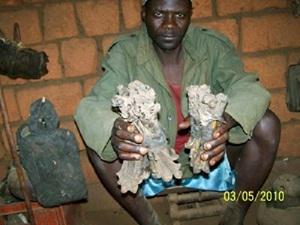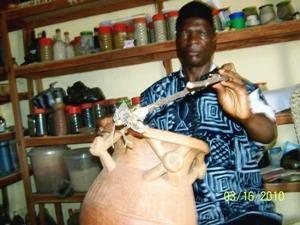Emmanuel Sama Liyong
Other projects
11 Oct 2011
Promotion of the Sustainable Use of Indigenous Wildlife Resources as Medicinal Wildlife, in Cameroon’s North-West Region II
This project is has two aims:
(i) a case study of the use and means of acquisition of indigenous wildlife resources as medicinal wildlife
(ii) to raise public awareness for the sustainable use and management of the identified species.

Tradi-practitioner with chimps & eagle bones.
Motivation:

Tradipractitioner showing a chameleon as medicinal species.
What motivated this case study was my realization that some medicine is derived from the wildlife of the mainly grassland North West Region of Cameroon, yet the unsustainable way the indigenous wildlife resources are used and traded is leading to the depletion and eventual extinction of some of them in the area.
Secondly, much has been talked, done and written on Medicinal Plants, but that is the contrary for Medicinal Wildlife, at least in Cameroon. Unlike medicinal plants, which are harvested as parts of trees and plants that are generally left intact, an animal is always killed for medicinal wildlife.
Long Term Goal:
The study aims, in the long-term, to achieve the sustainable use of Medicinal Wildlife after highlighting its importance in wildlife conservation in general and by seeking alternatives to those species highly killed for medicine or endangered.
From the study we will pick and propose some identified species for focussed protection by law, search alternatives especially for endangered species of medicinal wildlife, consider the ex-situ conservation of some, as well as seek funding to help some local hunters to obtain hunting licenses – as example in a legal practice which is quite rare here.
The result will be presented/circulated to government, conservation organisations and community based groups, who are expected to take it as a relay baton and impetus for more work in that line.
Planned Activities, Methodology and Timescale:
We will travel and collect data from 60 tradi-practitioners, on the use and means of acquisition of medicinal wildlife in the study area, using: Questionnaires, One-on-one interviews and Focus Group Discussions. We will rank identified species in order of medicinal importance, showing perceived levels of abundance or rarity; this to identify species which are very important as medicinal wildlife but low in the protection status.
We will link the findings through radio talk programs, distribution of flyers and posters, sketches, meetings and interactive discussions, for the awareness campaigns.
With the results we will confer with conservation stakeholders on possible alternatives and alternative actions. Recommendations will be proposed to the government and international conservation organisations, for possible policy change to better protect and sustain medicinal wildlife.